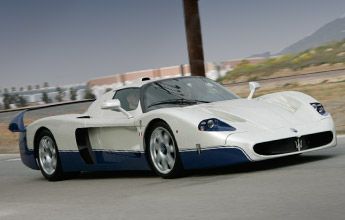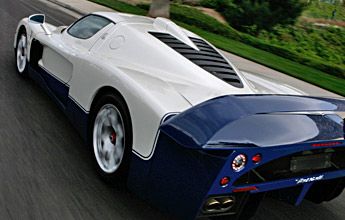A new record was smashed today. Five supercars, Enzo Ferrari, Koenigsegg CCX, Maserati MC12, Pagani Zonda F Clubsport and Porsche Carrera GT got together at the Nürburgring Nordschleife to see if any could set a new production car lap record around the 12.8 mile long circuit.
And the winner was Maserati MC12 with an incredible 7:24.29, not only fastest of the group but also setting a new production car lap record in the process. The MC12 was the heaviest car of the group, with ‘old fashioned’ steel brakes and conventional dampers, yet took them all on, and triumphed convincingly.
Second quickest was the Pagani, a bespoke creation of a small Italian niche builder, its enormous 7.3 liter Mercedes engine contributed to a remarkable time of 7:24.65.
Third quickest was the Enzo Ferrari, with a very impressive 7:25.21. It might have been able to go quicker – but the electronic dampers at the rear of the car stopped working, on two separate laps on different days.
Press release
It’s the kind of discussion that often crops up when car guys get together – which is the fastest? If money was no object, what supercar would you go for? Well, one person – with the aid of a support team and a professional driver – set out to answer the question, by seeing which of five cars would be the quickest around the legendary ‘Green Hell’, the Nürburgring Nordschleife. And in the process, to see if any could set a new production car lap record around the 12.8 mile long circuit. This is perhaps the most legendary of all race tracks, and it is the one that many manufacturers of high performance cars use to tune and benchmark their creations. The magic number a car accomplishes in putting together one spectacular lap of Der ‘Ring is often the ultimate accolade used in automotive marketing.
The cars in question, in alphabetical order, were an Enzo Ferrari, Koenigsegg CCX, Maserati MC12, Pagani Zonda F Clubsport and Porsche Carrera GT. These five – worth a cool $4.25 million in total – belong to one extremely lucky owner, who keeps them stabled close to the Nürburgring track. His support team enlisted the aid of American Le Mans Series racer Marc Basseng to do the driving, and evo magazine was on hand to record the results.
None of these cars are what might be termed ‘slow’ – they all make in excess of 600 hp, with the Koenigsegg tuned to make a frightening 901 hp. Yet the CCX, the most expensive car in the group, took the longest to complete a lap – fast in a straight line, the peaky way in which the power is delivered made it challenging to control. Next up was the Porsche Carrera GT, with the lap in 7:28.71 - meaning that Basseng matched the time set by factory driver Walter Röhrl in the final stages of the car’s development.
Third quickest was the Enzo Ferrari, with a very impressive 7:25.21. It might have been able to go quicker – but the electronic dampers at the rear of the car stopped working, on two separate laps on different days. The time is a tribute to Basseng’s perseverance and skill.
Second quickest was the Pagani, a bespoke creation of a small Italian niche builder, its enormous 7.3 liter Mercedes engine contributed to a remarkable time of 7:24.65. That’s an average of more than 103mph, on a track which has blind crests and turns, bumps and jumps, and almost no run-off areas.
And yet the Maserati MC12 went even quicker around the famed track in the Eifel Mountains. The MC12 posted an incredible 7:24.29, not only fastest of the group but also setting a new production car lap record in the process. The MC12 was the heaviest car of the group, with ‘old fashioned’ steel brakes and conventional dampers, yet took them all on, and triumphed convincingly. It wasn’t the fastest in the straights, but the car’s race-bred aerodynamics and Maserati engineering focused on making all the performance accessible meant it was consistently at or near the top of the cornering g-forces, allowing Basseng to get on the power harder and earlier than in its rivals, and its sure-footed handling meant that he had the confidence and ability to maintain consistent and smooth speed. Horsepower is not the sole factor in accessible performance; great balance is needed to make that power genuinely usable and not merely an academic ‘headline’ figure.
This balance has long been a hallmark of Maserati production and race cars. Often Maserati’s legendary race cars were not the most powerful cars on the grid, but their supreme balance allowed their drivers to extract the most useable performance, giving them the confidence to take the cars to the limit – and the race wins and championships followed. So too with Maserati street cars: the Quattroporte on paper has less power than some AMG or M-Power rivals, but the Quattroporte put them all away on evo magazine’s own test track. When evo retired their old track configuration earlier this year the Quattroporte still held the sedan lap record. Performance really does run in the Maserati family.
So the next time conversation turns to fast cars, you can now state with confidence that the MC12 is ultimately faster than the current crop of supercars – yet another example of Maserati’s dedication to making every car they build the best engineered and finest-handling model in its class. And while all fifty road going examples of the MC12 are long since sold, why not visit your local authorized Maserati dealer, and test drive the Quattroporte and GranTurismo; find out for yourself why now, more than ever, Maserati rules the roost.


